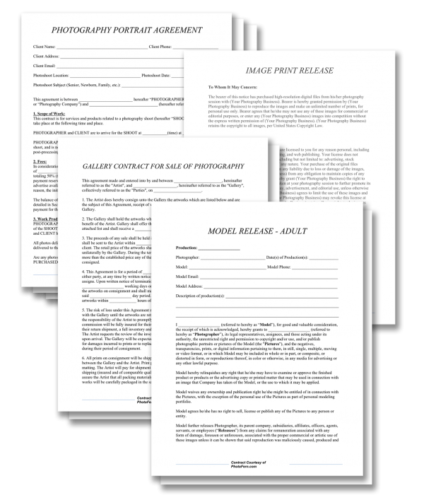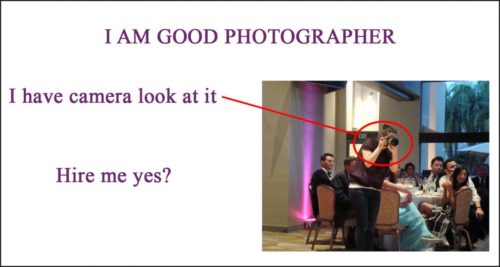Jenna Martin is a fine art and underwater photographer based in Montana. After acquiring her Master’s degree in Psychiatric Rehabilitation, she made a drastic career change into the field of photography, where she has been producing surreal images for the past two years. You can find her work on 500px, her website, or her Periscope. This article originally appeared here and is being republished with express permission.
I have to admit, when I first started my photography business I didn’t think it was going to be that difficult. I thought I’d get a camera, take some photos, put some stuff out on Facebook and people would start hiring me. They would give me money, I would give them photos—done deal! How tough could it be?
Well…as it turns out, it was a bit more complicated than that. But most of what I could find still focused on the photos—and I was struggling more with the business side of things. So for anyone else out there still in those beginning stages, here are a few things I had known for getting your photography business up and running.
Note: Most of the examples in this post are for wedding photography because that’s how I started. Now I’m a professional underwater portrait photographer. So if you go to my site and don’t see any wedding photos—that’s why. I figured these examples would be more relevant than underwater examples.
Price Your Work Correctly
It’s tough to come back from bad pricing. I shot my first wedding for $650, and it went awesome! That couple recommended me to everyone…as a wedding photographer that did great work and only charged $650. It took me awhile to realize I was actually losing money shooting weddings at that price. I didn’t know how to account for gear, insurance, travel costs, editing time, ordering costs and a whole lot of other stuff too. Bad pricing almost killed me in the beginning.
Finding your pricing sweet spot is kind of like a cruel treasure hunt. My advice for your first step – see what others are charging in your area. Not to compare yourself – but to research. This will at least give you a general idea of where the market is. Successful photographers aren’t shooting in a price range because they drew that number out of a hat, it took a while for them to get there, which means you can learn just as much from their price range. Here in Montana, for example, most wedding photographers stay around the $2,000 – $4,000 range. If you shoot in California or New York your average market prices are probably going to be a bit higher.
Then take a close look at everything that goes into your entire shoot – from planning all the way to delivering the photos. I’ve found that personally, between what I offer and what I have to spend (editing time, travel costs, everything), I was breaking even somewhere around $1,200.
Everyone is different, but this should give you at least a starting point.
Insure Your Gear
Chances are, if you’re just starting out, you’re spending a huge chunk of your savings (if not all of it) on new gear. You’ll need a camera and a couple decent lenses for almost any kind of photography you choose to pursue, and that doesn’t come cheap. Granted, with how fast photography technology is moving you can get a fantastic camera nowadays for a fraction of the price you’d have paid a few years ago, but it’s still going to leave a dent in your bank account. And if something ever happens to your gear (which something most definitely will), do you have the money to start over? Probably not. Insure your gear. It costs about $28/month to insure your gear with PPA. If it’s between that or a new lens, get the insurance.
Learn to Edit Efficiently
Of course you’ll want your shots to be the best they can be SOOC (straight out of camera), but part of what a client is paying you for is your post-processing skills. Skin retouching, color correcting, removing or adjusting things in the background (like fire hydrants or drunk in-laws): all these edits take time. And your time is valuable.
Try and develop a series of steps to editing, and get to know your shortcuts in Photoshop and Lightroom. For example, in Photoshop, pressing ‘B’ on your keyboard gives you the brush tool. It may not seem like much, but pressing ‘B’ instead of manually selecting the brush from your toolbar every single time makes a bigger difference than you think. The more shortcuts you use the more milliseconds it shaves off per photo, saving you hours of editing time.
And for the love of God go easy on the clarity and saturation sliders. You’ll thank me later.
Draw Up a Contract
I didn’t know I needed a client contract until a client asked for one. Whoops.
Thank God I got one though, because when you’re shooting weddings for as low as $650, you get taken advantage of, and without a decent contract there’s a couple times I probably wouldn’t have been paid at all.
Depending on what you shoot, there are countless different contracts you should be using. I shoot portraits, so I need a portrait agreement and a model release. My clients also receive digital files with some packages, so I also need a print release. I have a consignment agreement for art that is sold in galleries, plus a digital works agreement for my work that is used for book covers, websites and album covers.
For a basic portrait agreement, you’ll want to include spaces for both your company information and the client’s information, product or services to be agreed upon, deposit amount, cancelation terms (by both parties), date of delivery, and additional information, like travel fees, or shooting requirements. Almost all wedding photographers, for example, have a clause that ensures they are fed on the day of the wedding. My wedding photography contract guarantees me a piece of wedding cake because, well, I like cake.
As much as we want to believe the best in people, a handshake does not ensure you’ll be treated fairly. You’ll want at least something down on paper.

Contracts courtesy of www.photofern.com
Learn to Network
A hugely significant way photographers find clients is through referrals; referrals from happy clients and referrals through like-minded businesses. A wedding photographer should be working with local wedding venues, wedding planners and jewelry stores. A newborn photographer should be working closely with local baby boutiques, delivery centers and wedding photographers. A landscape photographer should be working with local magazines, hotels and tourism centers. No matter what you shoot, there are businesses and people you need to know. Don’t be shy here – if you want to run your own business you’ve got to put yourself out there.
Contact these companies and start building a relationship. Maybe you’ll give a venue free photos of every wedding shot at their place, and in return you’re first on a short list of recommended photographers they give to couples getting married at their facilities. Think about what you can offer them and what you want in return, then ask for a meeting!
Have an Online Presence
All those people and businesses you should be networking with? Without an online presence it’s very difficult for them to recommend you. They need a website they can send clients to, and social media accounts they can tag you in and pull up to show your work. When people hear about you, the first thing they’re going to do is whip out their phones and Google you. Make sure something comes up.
Get Your Marketing Materials Ready
Since I started out shooting mostly weddings, I thought I’d hit up a local bridal fair. So I printed some flyers, set up a booth and was quickly embarrassed. My “flyers” were a joke. I don’t have an actual example, but let’s just say they looked something like this:

Needless to say I got no new bookings, and the next day I tried to create my own handouts based on a few I had seen at the fair. It was a massive failure. Turns out, creating marketing materials is much more of an in-depth process than I originally thought. I probably should’ve just bit the bullet and bought a few templates to get me started, because I was just flat out no good at it and because nothing says “I have no idea what I’m doing” more than really crappy marketing materials.
Develop Your Portfolio
They always say, “Dress for the job you want, not the job you have.” You can also apply this to your portfolio. You want it full of photos that will lead you to the clients you want, not necessarily convey the clients you have.
For example, if you want to shoot destination weddings, you’ve got to get some portfolio shots of somewhere other than where you live. My first year I took a greyhound bus to the California coast, slept on peoples’ couches and gave out free “wedding-styled photoshoots.” Clients stepped back into their dress and a tux and we took pics at the Golden Gate Bridge in San Francisco, at the beach at sunset in Los Angeles and in downtown San Diego. I came back with a treasure trove of photos that looked nothing like Montana. Now it actually looked like I had shot some destination weddings.
Be Prepared to Explain Yourself
You know why I shot my first wedding for $650? Because that’s what they said they’d pay me, because that’s what they thought was fair. They didn’t know everything that goes into wedding photography, and that’s not their fault. If you’re going to charge enough to make a living, you have to be able to explain yourself to clients who think otherwise.
Practice this before your first sales meeting. You want to be confident in your answers. You aren’t asking them for charity – you’re explaining why your services are valuable.
Figure Out if this is Right for You
People told me I’d never enjoy photography if I did it for a living instead of just as a hobby. Are you freaking kidding me?! I do not love photography any less because I get paid for it. Getting paid for it just means I ABSOLUTELY LOVE MY JOB! No way would I trade this in. All the stress, the sleepless nights, the responsibility, everything – totally worth it. I wouldn’t go back in a heartbeat!
Of course, I have friends that have gone full-time and hated it. They liked the part where they pressed the shutter button, not where clients are badgering them 12 hours after a shoot wondering where their photos are.
Running a business isn’t for everyone – and there’s nothing wrong with that! If you want something stable without all the responsibility, maybe keep your day job. If you’re like me and have gotten fired from almost every job you ever had because you have a tiny problem with authority, running your own business might be a perfect fit.
Bonus Tip: Ignore the Facebook “Pros”
Oh, dear God, virtually every photographer on Facebook is lying. Yes they may be booking clients, but they are also dealing with horrible clients and cancelations, and broken gear and unexpected business expenses. No one posts about these things because it doesn’t look great, but trust me, that doesn’t mean they aren’t going through it.
No one is wildly successful from day one. We’re all just as much of a hot mess as you are, but what people post on Facebook is meant to convince you otherwise. Don’t fall for it. Just skip over it and focus on what you need to do to get better.
And if you’re starting out and you’re a bit overwhelmed—that’s why I created PhotoFern. Meant to be a complete resource for photographers, we have classes, downloadable client contracts, fully customizable marketing templates, a combination of 300+ Photoshop actions, Lightroom presets, textures and overlays as well as a lively and supportive community all focused on the same thing: making our photography business a success. Use the code PHOTOFERN16 and enjoy your first 2 weeks free, and if you have any questions, feel free to shoot me an email at jennamartinphoto@gmail.com or message me on my Facebook page. Be sure to follow me on Instagram and Periscope if you’d like to watch some of the underwater shoots from under the water.
Happy shooting!










Leave a reply